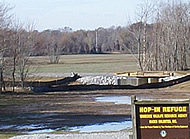
Online
Licensing
|
TWRA ADDRESSES CONCERN ASSOCIATED WITH HOP-IN REFUGE MANAGEMENT
 The Tennessee Wildlife Resources Agency has been notified by the Tennessee Department of Environment and Conservation (TDEC) that its request for a permit to restore the Hop-In Refuge/Black Swamp in West Tennessee has been denied. The Tennessee Wildlife Resources Agency has been notified by the Tennessee Department of Environment and Conservation (TDEC) that its request for a permit to restore the Hop-In Refuge/Black Swamp in West Tennessee has been denied.
“It is regrettable that TWRA is having this much difficulty in mitigating the past destruction of the Obion River system for the benefit of wildlife and the people of Tennessee,” said Ron Fox, TWRA Assistant Director. “Black Swamp was adversely affected through destructive channelization of the river by the U.S. Corps of Engineers in the 1960s and our goal has always been to bring the area back, as close as we could, to its pre-channelized state.”
The only area of construction was on TWRA owned land, which is dedicated for wildlife management. The area is not a natural area, park, or federal refuge.
The construction for the project was entirely on agricultural land.
The land was acquired following the settlement of a federal court action involving the West Tennessee Tributaries Project of the U.S. Army Corps of Engineers. Before this project was stopped, more than 200,000 acres of swamps and bottomlands hardwoods were drained, cleared and converted to agriculture.
These lands (referred to as Mitigation Lands) were transferred to TWRA for management in the mid-1990s. This transfer occurred after the Governor of Tennessee, Secretary of the Army, and the Secretary of Interior agreed in a Federal Court order to a specific tract by tract plan of management designed to mitigate for the wildlife and fishing recreational trips lost. Because a high percentage of the wildlife recreation losses were connected to the loss of water resources, (swamps and oxbows) the plan was written to maximize the creation of opportunities related to fisheries and waterfowl.
TWRA work involved adding three culverts in existing ditches that were dug by the previous landowners to drain the adjacent Black Swamp. A drop board water control structure was built in an agriculture field along a field road, which was renovated to establish a combination terrace and elevated farm access road to Hop-In Refuge.
The management plan created a water storage feature (swamp environment) as opposed to drainage into a channelized ditch. Funding for the project was carried out fully from sportsmen’s dollars. No tax funds or federal funds were used. Upon completion of this project, TWRA expected nearly 900 acres would be returned to a swamp environment during the winter months to attract ducks and improve hunting. During the planning process, TWRA foresters were consulted and agreed that there would be no harm to cypress and tupelo trees indigenous to the area.
“During the last six months our professionals have devoted significant time to address all questions that have been raised regarding the project,” Fox said. “We will now evaluate options for appeal that are identified in TDEC’s denial.”
|

|

